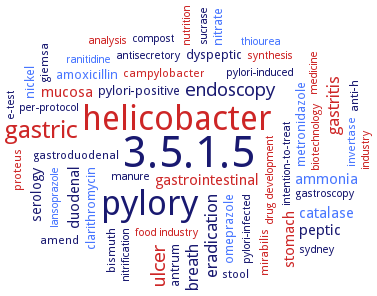3.5.1.5: urease
This is an abbreviated version!
For detailed information about urease, go to the full flat file.

Word Map on EC 3.5.1.5 
-
3.5.1.5
-
pylory
-
helicobacter
-
gastric
-
ulcer
-
endoscopy
-
gastritis
-
eradication
-
breath
-
gastrointestinal
-
duodenal
-
peptic
-
stomach
-
ammonia
-
catalase
-
mucosa
-
serology
-
clarithromycin
-
nitrate
-
nickel
-
amoxicillin
-
pylori-positive
-
antrum
-
dyspeptic
-
omeprazole
-
metronidazole
-
giemsa
-
proteus
-
anti-h
-
invertase
-
mirabilis
-
amend
-
campylobacter
-
stool
-
gastroduodenal
-
bismuth
-
nitrification
-
nutrition
-
lansoprazole
-
medicine
-
synthesis
-
antisecretory
-
pylori-infected
-
sydney
-
drug development
-
manure
-
compost
-
analysis
-
sucrase
-
thiourea
-
pylori-induced
-
ranitidine
-
per-protocol
-
industry
-
food industry
-
intention-to-treat
-
biotechnology
-
gastroscopy
-
e-test
- 3.5.1.5
-
pylory
- helicobacter
- gastric
- ulcer
-
endoscopy
- gastritis
-
eradication
-
breath
- gastrointestinal
- duodenal
-
peptic
- stomach
- ammonia
- catalase
- mucosa
-
serology
- clarithromycin
- nitrate
- nickel
- amoxicillin
-
pylori-positive
- antrum
-
dyspeptic
- omeprazole
- metronidazole
-
giemsa
- proteus
-
anti-h
- invertase
- mirabilis
-
amend
- campylobacter
-
stool
-
gastroduodenal
-
bismuth
-
nitrification
- nutrition
- lansoprazole
- medicine
- synthesis
-
antisecretory
-
pylori-infected
-
sydney
- drug development
-
manure
-
compost
- analysis
- sucrase
- thiourea
-
pylori-induced
- ranitidine
-
per-protocol
- industry
- food industry
-
intention-to-treat
- biotechnology
-
gastroscopy
-
e-test
Reaction
Synonyms
acid urease, Arthritogenic cationic 19 kDa antigen, BPU, canatoxin, embryo-specific soybean urease, Eu1, Eu4, HPU, jack bean urease, JBU, JBURE-II, More, PMU, urea amido hydrolase, Urea amidohydrolase, urease, urease JBURE-IIb, UreC
ECTree
Advanced search results
Source Tissue
Source Tissue on EC 3.5.1.5 - urease
Please wait a moment until all data is loaded. This message will disappear when all data is loaded.
-
expression of the urease operon is sensitive to the aspartate concentration in milk and to the cell availability of glutamate, glutamine, and ammonium ions

additional information
-
optimal pH for urease activity in whole and permeabilized cells and of cell free extracts differs slightly, but is in the range 6.0-7.0. Significant activity is retained at pH 3.0 and 8.0, and, for cell free extracts, at pH 4.0 in the presence of ethanol. Urease production is evaluated in fermentations with pH control (5.25-6.5) and without pH control. Very little urease is produced in absence of urea, which at 5 g/l slows growth significantly in fermentations without pH control, but prevented a decrease in pH below 5.1 and results in higher final biomass. Optimal pH for growth is between 6.0 and 6.5 but specific urease activity is higher for fermentations at low pH at the beginning of the exponential phase. However, a higher total urease activity is obtained at pH 6.0 and 6.5 because of higher biomass

expression of JBU and JBURE-II genes is induced in seedlings and in leaves treated with abscisic acid, a phytohormone involved in seed maturation and wound reponse

the expression of JBU and JBURE-II genes is induced in seedlings and in leaves treated with abscisic acid, a phytohormone involved in seed maturation and wound reponse

-
soybean contains an ubiquitous urease (encoded by Eu4) that is synthesized in all tissues, as well as an embryo-specific urease (encoded by the gene Eu1) that is confined to the developing embryo and is retained in mature seeds where its activity is roughly 1000fold higher than that of ubiquitous urease

Eu4 expression is more prominent in seeds one day after dormancy break whereas Eu1 predominates in developing seeds

expression of JBU and JBURE-II genes is induced in seedlings and in leaves treated with abscisic acid, a phytohormone involved in seed maturation and wound reponse

the expression of JBU and JBURE-II genes is induced in seedlings and in leaves treated with abscisic acid, a phytohormone involved in seed maturation and wound reponse



 results (
results ( results (
results ( top
top






